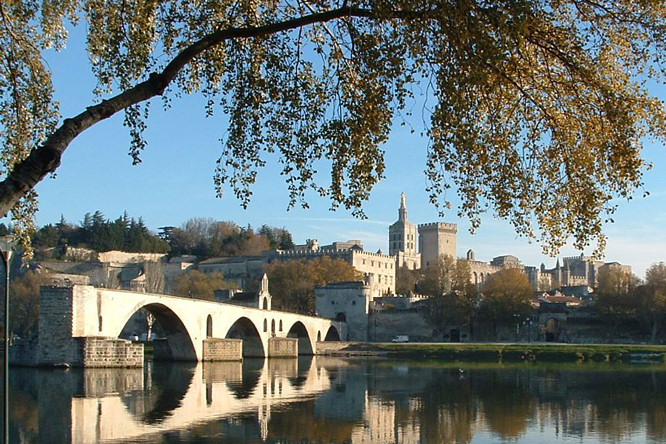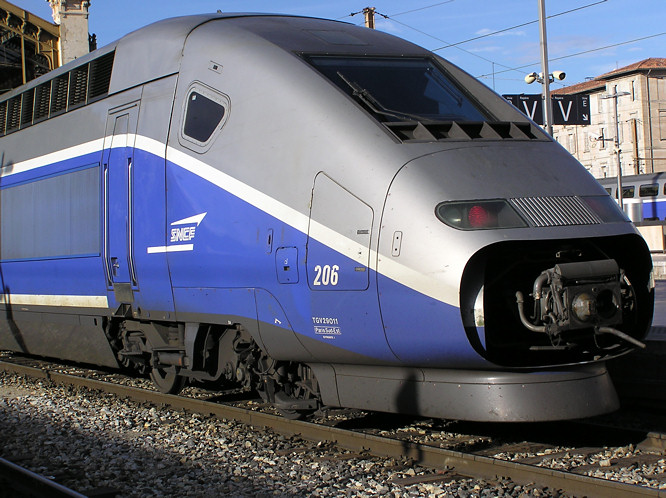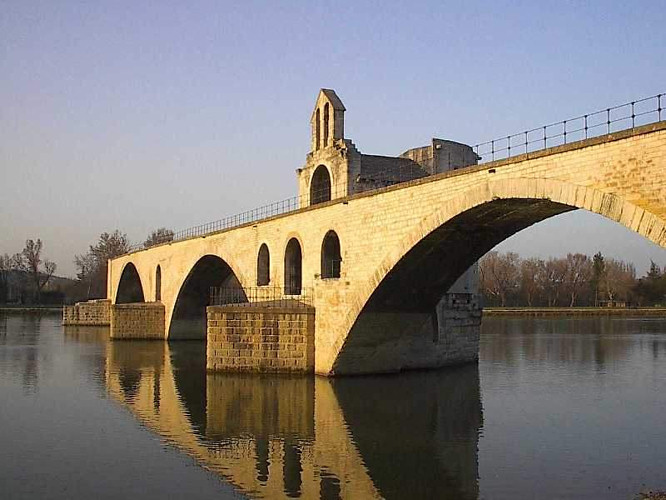Avignon South of France City Break
Avignon is on the TGV line from Paris to Marseille, It takes about 3 hours from Paris Gare de Lyon Railway Station. The modern TGV Station is about 2km outside of the city. There is a cheap regular bus that will take you into Avignon centre. It is called the TGV Navette.

It drops you in the square outside the main post office just opposite the railway station that serves the local rail network. You can take the Eurostar train from London St Pancras International Station to Avignon via Paris. It takes about 6 hours in total.
Avignon in Provence, South of France is a treasure trove of attractive ancient and medieval architecture. It was once the capital of Christendom in the 14th century when the Pope and the papal court moved from the Vatican in Rome to Avignon in France. You can now go for a romantic weekend break by Eurostar train from London. Alternatively you can take a plane to Avignon or Marseille airport.

The Bridge of Avignon - Pont D'Avignon
This bridge of Avignon over the river Rhone in the south of France is also known as the Saint Benezet Bridge. It is a very bizarre site. It looks like an unfinished bridge and appears as if the local council just ran out of money halfway through the building project.
A local shepherd boy called Benezet claimed angels visited him and told him to go to Avignon and build a bridge over the river Rhone. He crossed the Rhone by ferry, and in midstream announced that he was going to build a bridge. This was not the news the ferryman wanted to hear. Bent on eliminating unfair competition, the Rhone Ferryman tried to through Benezet overboard.
The Shepherd Benezet then marched in to Avignon cathedral. He again announced in a voice loud enough to be heard over the Mass, his desire to build a bridge over the river Rhone and the fact that he had received a vision. He was kicked out of the cathedral.
Benezet waited outside Avignon cathedral and repeated his story to the faithful. This annoyed the Bishop of Avignon who wanted to prove that Benezet was an evil lying child. He set him a task. He pointed to a huge rock, and asked the boy to pick it up. Benezet did so as if he was just lifting it a pebble.

Now convinced of the truth of the miracle the rock was used as part of the foundation for the first arch. Local moneyed leaders backed the project. After his death, he was interred on the bridge itself, in a small chapel standing on one of the bridge's surviving piers on the Avignon side.
The bridge once spanned the banks of the Rhone river. Now only the Avignon side of the bridge is intact. The Avignon side of the bridge has a chapel and the grave of Saint Benezet. The chapel was also was home to the bargemen for worship until it became unsafe and a new chapel was built at the entrance to the bridge in the 18th Century.
There is also a popular nursery rhyme 'Sur le pont d'Avignon' about the bridge that is popular with children. The bridge was completed in 1185. In 1226 it was destroyed. It suffered frequent collapses during floods and had to be reconstructed several times. Several arches were already missing and spanned by wooden sections before the remainder was damaged beyond repair in 1660. Despite a reconstruction effort, it was abandoned for good in 1680. Only four of the initial 22 arches remain. To access it, you have to follow the top of the medieval wall from the palace down to the bridge. There's a small entrance fee. A combined entrance fee to both the Papal Palace and the Bridge of Avignon is available.
The church built over Pont d'Avignon in the middle is in fact split into two chapels. The Romanesque-style lower level is called Chapelle Saint-Benezet, and dates from the 12th century. It once held the relics of Saint-Benezet. Above it is Chapelle Saint Nicolas, the Gothic church dating back from the 13th century. No it does not hold the relics of father Christmas. Much like the bridge underneath, the two chapels lie in ruins.
Avignon is commemorated by the French children's song, 'Sur le pont d'Avignon' ('On the bridge of Avignon'), which describes folk dancing. Here are the words in French and English with dancing instructions.
On y danse, on y danse - Everyone is dancing
(Everyone holds hands in a circle and skips around to the left.)
Sur le pont d'Avignon - On the bridge of Avignon
On y danse, tous en rond - Everyone is dancing in a circle
(Reverse the direction of the circle.)
Les jeunes filles font comme ci - The young girls go like this
(Girls step into the center of the circle, curtsy and return to their places.)
Les garcons font comme ca - The boys go like that
(Boys go to the center, bow and return.)
Sur le pont d'Avignon - On the bridge of Avignon
On y danse, on y danse - Everyone is dancing
(Everyone holds hands in a circle and skips around to the left.)
Sur le pont d'Avignon - On the bridge of Avignon
On y danse, tous en rond - Everyone is dancing in a circle
(Reverse the direction of the circle.)
Les poupees font comme ce - The dolls go like this
(Boys and girls move to the center and back like stiff walking dolls.)
Les soldats font comme ca - The soldiers go like that
(Boys and girls march to the center like soldiers, salute and return.)
Sur le pont d'Avignon - On the bridge of Avignon
On y danse, on y danse - Everyone is dancing
(Everyone holds hands in a circle and skips around to the left.)
Sur le pont d'Avignon - On the bridge of Avignon
On y danse, tous en rond - Everyone is dancing in a circle
(Reverse the direction of the circle.)
Les grenouilles font comme ci - The frogs go like this
(Hop like frogs to the center and back)
Les gorilles font comme ca - The gorillas go like that
(Thump your chests like gorillas, to the center and back.)
Sur le pont d'Avignon - On the bridge of Avignon
On y danse, on y danse - Everyone is dancing
(Everyone holds hands in a circle and skips around to the left.)
Sur le pont d'Avignon - On the bridge of Avignon
On y danse, tous en rond - Everyone is dancing in a circle
(Reverse the direction of the circle.)
Travel books

